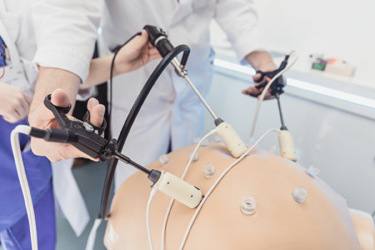Surgical Simulation Training: Trends For 2022 & Beyond
By Raimundo Sierra, Ph.D., cofounder and CEO, VirtaMed

Over the past decade, computer-based simulation has grown in impact, strength, and popularity among consumers and surgeons alike as simulation technology companies pursue ever-higher realism. Up until the early 2000s, high-fidelity simulation was restricted by the available computing power. The revolution in computer graphic cards allowed the gaming industry to make huge strides in speed, visuals, and usability. In parallel, medical simulation teams also adopted gaming engines and technology and are now programming with a unique fidelity, effectively mapping surgical procedures including those involving tissues, surfaces, deformations, cutting, and bleeding with realistic visual and haptic results.
As the founder and CEO of a surgical simulation company, I’ve had the privilege of watching and experiencing this industry evolve from its infancy, and I’m excited about the innovations I’ve seen that will inform and unleash the future of this technology. Here are some of the broader trends that I expect will have an impact on medical simulation in the years ahead.
Data’s Increased Role In Driving Surgical Simulation Innovation
As data-driven assessment takes greater hold across the industry, I believe educational simulation equipment that doesn’t produce measurable data will eventually disappear. Over time, box trainers that have nothing to quantify, or mock surgeries that don’t validate a surgeon’s skills performance, will become obsolete. What will persist is technology that provides a clear patient benefit and is easy for surgeons to use and master.
For example, the Arthroscopy Association of North America (AANA), a leader in advancing the field of minimally invasive orthopedic surgery, has developed a way of measuring the specific successes and failures within surgical procedures. Known as “Copernicus metrics,” these data points establish a simple, binary way of determining whether a surgery is being performed correctly and in line with the targets set by the expert panel.
Using this method of performance measurement, simulation companies are in a position to develop new forms of assessments to validate success in a simulated environment and understand the impact of simulated surgical education on trainees. This new use of data can be mapped into simulation training software, providing trainees with real-time reports and feedback on performance and quantifying a process that had previously been purely qualitative.
As the market grows, it’s clear that data will drive the industry and the rapid adoption of simulation. Virtual reality simulation technology has helped lead that charge as a vessel to collect data that can’t be replicated in an operating room or from other types of surgical education, such as cadavers or training boxes.
Patient Recorded Outcomes Could Transform The Evaluation Of Patient Care
Quantitative data-supported results from simulated surgical procedures may end up having a greater impact beyond improving initial surgeon training. As these assessments become more accepted across healthcare, they could ultimately be used to support a concept known as patient-reported outcomes (PRO). PRO places patient health, safety, and experience as the primary success metrics to validate the effectiveness of medical procedures and the doctors or surgeons performing those operations.
To demonstrate this concept, take a procedure like a rotator cuff repair in the shoulder that typically involves multiple steps. Those steps can be mapped into a training simulator to give surgeons step-by-step instructions on how it can and should be performed properly. Once a surgeon has been thoroughly trained on those steps, they can be assessed on variables such as accuracy, efficiency, and speed. When training is fully integrated with surgeries, this assessment can even be linked to how well the patient recovers after surgery, if they have full mobility, or if they may need to be readmitted. A system with PRO at the center provides a way to connect all of these dots and ultimately improve patient care.
However, there are currently limitations to realizing this concept. Healthcare systems aren’t facilitating this kind of open data network due to data privacy issues and the potential threat of individual malpractice cases. Additionally, the current fragmented incentives between doctors, hospitals, and insurance companies are similarly likely to limit the adoption of PRO.
To validate this concept, medical simulation companies first need to work with associations and institutions to show that the effect of simulation training translates into a positive benefit for both the surgeon and the patient. From there, the industry needs to show healthcare systems how modifying their reimbursement practices could properly reward surgeons by linking patient outcomes to surgical training. That level of data flow throughout the entire treatment pathway of a patient – including feedback systems during surgery linked to PROs – is still years away, but if fully realized, it could radically shift how we interpret success in the medical field.
The Continued Evolution Of The Digital Twin For Both Patient And Surgeon
Using a surgical training simulator with a surgeon, and potentially also a surgical robot, opens up a wide range of scenarios for patient replication. That’s where the concept of digital twins will lead to new possibilities for healthcare and reduction in intraoperative challenges and improved patient outcomes. At its base level, digital twins are collections of data and computer models that can replicate the actions and environments of different individuals or populations in training as well as in the OR. When we think about this in the context of surgical simulation and education, there are two particularly interesting use cases worth mentioning: the digital twin patient and the digital twin surgeon.
At the most general level, the “digital twin patient” provides a patient model that captures the anatomical variations a surgeon can expect to encounter in the operating room, from general size and position to the number of pathologies present in the body. Within simulation technology, trainee surgeons can practice a broad range of scenarios on these digital twin patients. The digital twin patient can also be individualized. A specific patient’s anatomy can be replicated digitally, allowing surgeons to rehearse a procedure with a single patient in mind. This would typically be for a patient with a complex or unique pathology, or for certain steps in an operation that the surgeon is less familiar with.
On the other side of the coin, the “digital twin surgeon” is a digital representation of a surgeon’s skills and expertise. A digital surgeon can take many roles in surgical training. It can provide basic-level instruction, such as mentoring and guiding a trainee through a virtual surgery or skills assessment. It also can offer higher-level benefits such as assisting a primary surgeon in an operating room in real time. Like with digital twin patients, digital twin surgeons can be based on data for generalized surgical skills or be a “twin” of a specific surgeon performing a specific procedure.
Using simulation technology, we can measure many aspects, from how the surgeon performs a surgery to how the digital patient reacts. Using machine learning, simulator algorithms can be trained to instruct based on how best-in-class surgeons are performing these procedures. From there, we can start to add variables such as how a beginner, intermediate, or expert surgeon performs a surgery not only in training but also in the OR.
Innovations Will Drive Simulation Forward — If We Let It
In healthcare, for the benefit of patients, we need to leverage assets that are being produced in the larger technology industry and lean into what’s possible with machine learning and system optimization to continually unleash the potential of simulation. Ultimately, that will enable companies to move from the past, where they released a new simulator perhaps once a year, to a point where they can release new content on a regular basis that covers the variability we see in real-life patients. Once there, we can continually provide new realistic learning content for surgeons, integrating these feedback loops during the surgery and ultimately producing a better patient outcome.
About The Author:
 Raimundo Sierra, Ph.D., co-founded VirtaMed in 2007. As CEO, he has driven the development of the company’s long-term growth strategy and guided the transition from a start-up to a globally present company. At first unfamiliar with computers, Sierra quickly discovered his passion for software, algorithms, computer vision, and its application to non-engineering fields at ETH Zurich and through his postdoctoral research on simulation technology in Boston. Over the years, he has also served as a consultant at McKinsey and as head of a corporate digitization unit at Syngenta.
Raimundo Sierra, Ph.D., co-founded VirtaMed in 2007. As CEO, he has driven the development of the company’s long-term growth strategy and guided the transition from a start-up to a globally present company. At first unfamiliar with computers, Sierra quickly discovered his passion for software, algorithms, computer vision, and its application to non-engineering fields at ETH Zurich and through his postdoctoral research on simulation technology in Boston. Over the years, he has also served as a consultant at McKinsey and as head of a corporate digitization unit at Syngenta.
